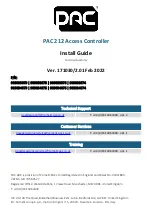
eUSCI_B Operation – I
2
C Mode
967
SLAU356I – March 2015 – Revised June 2019
Copyright © 2015–2019, Texas Instruments Incorporated
Enhanced Universal Serial Communication Interface (eUSCI) – I
2
C Mode
26.3.4.2.1 I
2
C Master Transmitter Mode
After initialization, master transmitter mode is initiated by writing the desired slave address to the
UCBxI2CSA register, selecting the size of the slave address with the UCSLA10 bit, setting UCTR for
transmitter mode, and setting UCTXSTT to generate a START condition.
The eUSCI_B module waits until the bus is available, then generates the START condition, and transmits
the slave address. The UCTXIFG0 bit is set when the START condition is generated and the first data to
be transmitted can be written into UCBxTXBUF.
The UCTXSTT flag is cleared as soon as the complete
address is sent.
The data written into UCBxTXBUF is transmitted if arbitration is not lost during transmission of the slave
address. UCTXIFG0 is set again as soon as the data is transferred from the buffer into the shift register. If
there is no data loaded to UCBxTXBUF before the acknowledge cycle, the bus is held during the
acknowledge cycle with SCL low until data is written into UCBxTXBUF. Data is transmitted or the bus is
held, as long as:
•
No automatic STOP is generated
•
The UCTXSTP bit is not set
•
The UCTXSTT bit is not set
Setting UCTXSTP generates a STOP condition after the next acknowledge from the slave. If UCTXSTP is
set during the transmission of the slave address or while the eUSCI_B module waits for data to be written
into UCBxTXBUF, a STOP condition is generated, even if no data was transmitted to the slave.
In this
case, the UCSTPIFG is set.
When transmitting a single byte of data, the UCTXSTP bit must be set while
the byte is being transmitted or any time after transmission begins, without writing new data into
UCBxTXBUF. Otherwise, only the address is transmitted. When the data is transferred from the buffer to
the shift register, UCTXIFG0 is set, indicating data transmission has begun, and the UCTXSTP bit may be
set. When UCASTPx = 10 is set, the byte counter is used for STOP generation and the user does not
need to set the UCTXSTP.
This is recommended when transmitting only one byte.
Setting UCTXSTT generates a repeated START condition. In this case, UCTR may be set or cleared to
configure transmitter or receiver, and a different slave address may be written into UCBxI2CSA, if desired.
If the slave does not acknowledge the transmitted data, the not-acknowledge interrupt flag UCNACKIFG is
set. The master must react with either a STOP condition or a repeated START condition. If data was
already written into UCBxTXBUF, it is discarded. If this data should be transmitted after a repeated
START, it must be written into UCBxTXBUF again. Any set UCTXSTT or UCTXSTP is also discarded.
shows the I
2
C master transmitter operation.















































